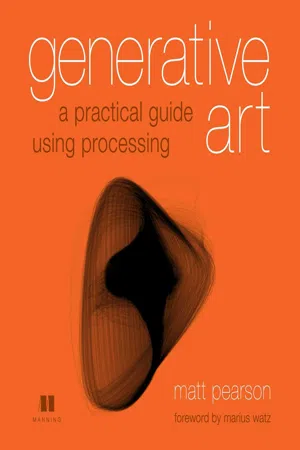
- 240 pages
- English
- ePUB (mobile friendly)
- Available on iOS & Android
About this book
Summary Generative Art presents both the technique and the beauty of algorithmic art. The book includes high-quality examples of generative art, along with the specific programmatic steps author and artist Matt Pearson followed to create each unique piece using the Processing programming language.
About the Technology
Artists have always explored new media, and computer-based artists are no exception. Generative art, a technique where the artist creates print or onscreen images by using computer algorithms, finds the artistic intersection of programming, computer graphics, and individual expression. The book includes a tutorial on Processing, an open source programming language and environment for people who want to create images, animations, and interactions.
About the Book
Generative Art presents both the techniques and the beauty of algorithmic art. In it, you'll find dozens of high-quality examples of generative art, along with the specific steps the author followed to create each unique piece using the Processing programming language. The book includes concise tutorials for each of the technical components required to create the book's images, and it offers countless suggestions for how you can combine and reuse the various techniques to create your own works. Purchase of the print book comes with an offer of a free PDF, ePub, and Kindle eBook from Manning. Also available is all code from the book.
What's Inside
- The principles of algorithmic art
- A Processing language tutorial
- Using organic, pseudo-random, emergent, and fractal processes
========================================?=========
Table of Contents
Part 1 Creative Coding
- Generative Art: In Theory and Practice
- Processing: A Programming Language for Artists Part 2 Randomness and Noise
- The Wrong Way to Draw A Line
- The Wrong Way to Draw a Circle
- Adding Dimensions
- Part 3 Complexity
- Emergence
- Autonomy
- Fractals
Frequently asked questions
- Essential is ideal for learners and professionals who enjoy exploring a wide range of subjects. Access the Essential Library with 800,000+ trusted titles and best-sellers across business, personal growth, and the humanities. Includes unlimited reading time and Standard Read Aloud voice.
- Complete: Perfect for advanced learners and researchers needing full, unrestricted access. Unlock 1.4M+ books across hundreds of subjects, including academic and specialized titles. The Complete Plan also includes advanced features like Premium Read Aloud and Research Assistant.
Please note we cannot support devices running on iOS 13 and Android 7 or earlier. Learn more about using the app.
Information
Part one. Creative Coding
“The machine makes the music, but I created the machine... I don’t know where responsibility lies in that situation.Autechre’s Sean Booth, in interview, 2010
Chapter 1. Generative Art: In Theory and Practice
1 You can read Prof. Galanter’s paper in full at www.philipgalanter.com/downloads/ga2003_paper.pdf.
1.1. Not your father’s art form
2 Richard Dawkins’ book The Blind Watchmaker (1986) is a good, accessible introduction to the topic of genetic algorithms and their application.
Figure 1.1. Tube Clock (2009)

1.2. The history of a new idea
3 Even though Processing can be used to create generative music, this book focuses solely on the creation of visuals. Generative music is a huge and fascinating topic that warrants a book of its own. David Toop’s Haunted Weather might be a good place to start.
Table of contents
- Copyright
- Dedication
- Brief Table of Contents
- Table of Contents
- List of Artworks
- Foreword
- Preface
- Acknowledgments
- About this Book
- About the Author
- Introduction: The Organic vs. The Mechanical
- Part one. Creative Coding
- Chapter 1. Generative Art: In Theory and Practice
- Chapter 2. Processing: A Programming Language for Artists
- Part two. Randomness & Noise
- Chapter 3. The Wrong Way to Draw a Line
- Chapter 4. The Wrong Way to Draw a Circle
- Chapter 5. Adding Dimensions
- Part three. Complexity
- Chapter 6. Emergence
- Chapter 7. Autonomy
- Chapter 8. Fractals
- Index
- List of Figures
- List of Tables
- List of Listings